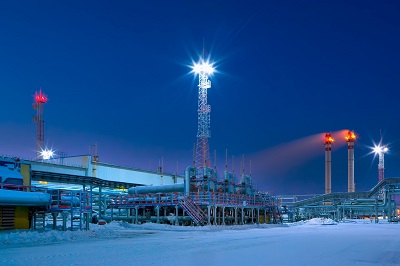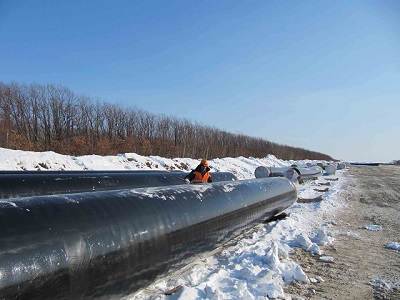Gazprom: 2015 Exceeded Expectations
Vitaly Markelov, Deputy Chairman of Gazprom Management Committee, has highlighted the company’s success in oil and gas production and exploration in 2015.
Last year, the Russian company conducted geological exploration for oil and gas in European Russia, Eastern and Western Siberia, the Arctic and Far Eastern shelves as well as in Vietnam, Algeria, Tajikistan and Kyrgyzstan.
As a result, reserves estimates in Russia grew by 582 million tons of fuel equivalent, including 510.8 billion cubic meters of gas, 68.4 million tons of gas condensate and 2.8 million tons of oil.
 Yamal
Yamal
Yamal is among the most strategically important oil- and gas-bearing regions in Russia and Gazprom is building production capabilities at the region’s largest field, Bovanenkovskoye. By 2030, the annual gas production is expected to climb to 360 billion cubic meters, says Markelov.
As of January 1, 2016, the facilities operated at Bovanenkovskoye include a comprehensive gas treatment unit with an annual aggregate capacity of 90 billion cubic meters of gas, a 375 MW booster compressor station and 303 wells. The field’s Cenomanian-Aptian deposits will be developed at three gas production sites. With 1,460 MW of booster capacities and 775 wells, the sites will annually yield 115 billion cubic meters of gas when up and running.
Sakhalin
The bulk of natural gas production at the Sakhalin gas production center comes from the Kirinskoye and Yuzhno-Kirinskoye fields developed under the Sakhalin III project. In 2015, the Kirinskoye field produced some 600 million cubic meters of gas and 100 thousand tons of gas condensate.
 This year, the company plans to recover about 1.12 billion cubic meters of gas and 182 thousand tons of gas condensate. The construction of production wells at the Kirinskoye field continues. Drilling is performed with Gazprom’s own floating drilling rigs, Polyarnaya Zvezda and Severnoye Siyaniye.
This year, the company plans to recover about 1.12 billion cubic meters of gas and 182 thousand tons of gas condensate. The construction of production wells at the Kirinskoye field continues. Drilling is performed with Gazprom’s own floating drilling rigs, Polyarnaya Zvezda and Severnoye Siyaniye.
At present, the Yuzhno-Kirinskoye field has eight prospecting and exploratory wells. The field is expected to come on stream in 2021. It is forecasted to produce 21 billion cubic meters of gas (37 production wells in total). The field is expected to reach the design capacity in the eleventh year of its development.
U.S. and E.U. sanctions apply to the procurement of American and European equipment for deep-water (over 500 feet, or 150 meters) hydrocarbon production and to the development of the Yuzhno-Kirinskoye field.
Today, the impact of the sanctions on geological exploration is not significant, says Markelov. “In order to bore prospecting wells at the Yuzhno-Kirinskoye field, the company employs drilling contractors from the countries that refrained from imposing economic sanctions on Russia. The same practice can be applied to high-tech subsea equipment. Gazprom’s experts believe that the U.S. and E.U. sanctions won’t significantly affect the commissioning timeframe of the Yuzhno-Kirinskoye field.”
.jpg) In February 2014, Gazprom and Royal Dutch Shell signed the Memorandum providing for the elaboration of project documentation for the third production train of the LNG plant within the Sakhalin II project. Experts have developed an integrated concept for the construction of an LNG plant production train with a capacity of up to 5.4 million tons per year, an additional LNG storage facility, and port installations, as well as for the build-up of transport capacities from the Onshore Processing Facility in the north of the Sakhalin Island to the LNG plant.
In February 2014, Gazprom and Royal Dutch Shell signed the Memorandum providing for the elaboration of project documentation for the third production train of the LNG plant within the Sakhalin II project. Experts have developed an integrated concept for the construction of an LNG plant production train with a capacity of up to 5.4 million tons per year, an additional LNG storage facility, and port installations, as well as for the build-up of transport capacities from the Onshore Processing Facility in the north of the Sakhalin Island to the LNG plant.
In June 2015, Gazprom and Royal Dutch Shell signed the Memorandum to construct the third production train of the LNG plant within the Sakhalin II project. The Memorandum sets out the target dates for the design stage and overall project implementation. It also outlines the further steps and basic principles of interaction between the parties during project preparation for the final investment decision. Last December, Sakhalin Energy Investment Company Ltd. – the Sakhalin II project operator – started to elaborate the project documentation.
 Vietnam
Vietnam
Based on the 1992 Production Sharing Agreements for licensed blocks 05–2 and 05–3, which Gazprom Group joined in 2013, the company is now developing the Moc Tinh and Hai Thach fields. The project is at the production stage. Two production platforms, an integrated gas treatment platform, a floating storage terminal for liquid hydrocarbons and a submarine pipeline and cable system have been built. The construction of production wells is underway.
The commercial production of hydrocarbons in the area started in 2013, and Gazprom expects to achieve the planned gas production level of two billion cubic meters per year in 2016. Drilling is expected to be completed in the first half of 2017.
At the same time, Gazprom is actively engaged in hydrocarbon prospecting and exploration in Vietnam. The analysis of geological and geophysical data helped identify 22 prospective formations, seven of which have been prepared for exploratory drilling. Two deep-water appraisal wells have been constructed at the Than Bien formation. A methane field (with a methane content of up to 98 percent) has been discovered.
Gazprom is currently interpreting seismic data to estimate gas reserves.
Production Exceeds Targets
Gazprom had approved the 2015 gas production plan in the amount of 485.36 billion cubic meters, but due to the declining demand that amount was revised down to 414.1 billion cubic meters. The actual output was 418.5 billion cubic meters, including 8.4 billion cubic meters of associated petroleum gas.
While it had been expected to produce 15 million tons of gas condensate in 2015, the actual production amounted to 15.3 million tons, thus showing a 0.9 million ton increase as compared to 2014. Oil production in the Gazprom Group hit a record high of 36 million tons last year, surpassing the 2014 level by 0.7 million tons. Taking subsidiary companies into account, the total oil production was 53.5 million tons.
The approved 2016 production plan is 452.45 billion cubic meters of gas, 15.6 million tons of gas condensate and 38.9 million tons of oil. The increment of domestic reserves in 2016 is expected to reach 511.4 million tons of fuel equivalent, including 478.2 billion cubic meters of gas. The bulk of growth will be observed in Eastern Siberia and the Far East (Chayandinskoye, Kovyktinskoye, and Yuzhno-Kirinskoye fields). The company also expects to discover additional reserves in the Yamal-Nenets Autonomous Area and on the Kara Sea shelf.
